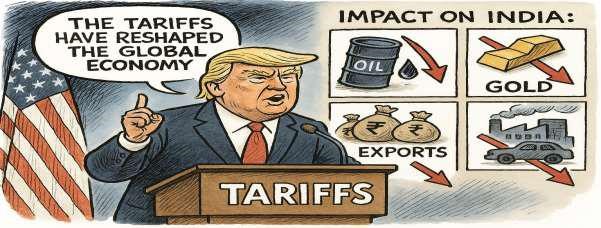
Introduction: A Global Trade Earthquake
The global economy has experienced a significant disruption. Former U.S. President Donald Trump has announced sweeping new tariffs that could completely reshape global trade. His decision to impose a 10% baseline tariff on all imports into the United States has triggered reactions from businesses, investors, and policymakers worldwide. Some see it as a bold move to protect American jobs; others fear it could lead to higher prices, supply chain disruptions, and economic uncertainty.
For India, one of the fastest-growing economies, this policy presents both challenges and opportunities. From fluctuating oil prices to potential risks in exports, these tariffs could impact key industries in unexpected ways. Will India gain an advantage in global trade, or will it struggle with rising costs? This article breaks it all down, helping you understand what’s at stake and how it could affect your business, investments, and daily life.
Trump’s New Tariffs: What’s Changing?
Targeted higher tariffs on specific countries:
- 34% on Chinese imports
- 25% on Canadian goods
- 20% or more on imports from the EU, Japan, and South Korea
- 46% on Vietnamese goods
- 25% on U.S. pharmaceutical companies operating in Ireland
- A 10% tariff on all goods entering the U.S
The goal is to encourage domestic manufacturing, but the ripple effects are being felt worldwide. Businesses are worried about rising costs, potential trade wars, and disruptions in the supply chain.
Immediate Effects on Global Commodity Markets
Oil Prices Drop Amid Global Uncertainty
Oil prices have fallen nearly 3% as investors worry that the tariffs could slow down global economic growth.
- crude is now at $72.98 per barrel, while U.S. West Texas Intermediate has dipped to $69.73.
- Lower oil prices may seem like good news for India, which imports over 80% of its oil, but if global demand weakens, the long-term effects could be unpredictable.
Gold Prices Soar as Investors Seek Safety
Whenever uncertainty hits the markets, investors rush to gold—and this time is no different. For instance, during the 2008 financial crisis and the COVID-19 pandemic, gold prices soared as investors sought safe-haven assets.
- Gold prices have surged close to record highs as people seek a safe-haven asset.
- If tensions escalate further, gold could continue to rise, impacting both investors and India’s jewellery industry.
Metals Face Mixed Reactions
- Copper prices have fallen due to concerns over slowing industrial activity, particularly in China, the world’s biggest copper consumer.
- Steel and aluminium prices have seen volatility, as tariffs increase production costs and disrupt supply chains.
- Rising steel prices could impact India’s construction and automobile industries.
India’s Economy: What’s at Stake?
India’s economy is deeply connected to global trade, and Trump’s tariffs could have far-reaching consequences across multiple sectors:
Energy and Oil Prices
- Lower oil prices may reduce inflation and bring down fuel costs, benefiting consumers and businesses alike.
- However, if oil producers cut supply to adjust to the price drop, this advantage could be short-lived.
IT and Technology Sector
- The IT sector might face uncertainty, as U.S. companies could cut costs due to higher operational expenses.
- Major IT firms like Infosys, TCS, and Wipro might see slower demand.
Pharmaceutical Industry
- Increased scrutiny on U.S. drug imports may impact Indian exporters like Sun Pharma and Dr. Reddy’s.
- If tariffs extend to pharmaceuticals, India’s generic drug market could face pressure.
Textile and Apparel Exports
- The textile industry might struggle with rising raw material costs, making exports less competitive.
- Export-dependent sectors could face reduced demand due to higher costs in the U.S. market.
Automobile Industry
- The automobile sector could be hit hard if higher tariffs make importing parts more expensive, pushing up car prices for consumers.
- Indian auto manufacturers relying on U.S. exports might see declining demand.
Conclusion:
Trump’s tariffs have introduced a new wave of complexity in global trade, presenting India with both obstacles and opportunities. While economic uncertainties may create short-term challenges, they also open doors for India to reinforce its position in the global market. By fostering resilient domestic industries, pursuing strategic trade partnerships, and implementing forward-thinking policies, India can not only withstand the impact of these tariffs but also emerge stronger. The ability to adapt and innovate in response to shifting trade dynamics will be crucial in shaping India’s long-term economic success.
Until then, Happy Trading!
Commodity Samachar Securities
We Decode the Language of the Markets
Also Read: Heatwave Fuels Water Demand – Investment Opportunities to Watch! , Will Indian Markets End the Day in Green Despite Tariff Impact?
Recommended Read: India’s Semiconductor Surge: Powering the Future of Electronics!
Want Help On Your Trades ?
Chat with RM